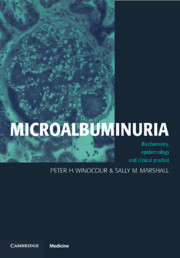Book contents
- Frontmatter
- Contents
- Preface
- Foreword by Professor K. G. M. M. Alberti
- 1 Renal structure and physiology
- 2 Measurement and expression of microalbuminuria
- 3 Epidemiology and determinants of microalbuminuria in health
- 4 Microalbuminuria in diabetes mellitus
- 5 Microalbuminuria as a marker of endothelial dysfunction
- 6 Microalbuminuria, cardiovascular risk factors and cardiovascular disease
- 7 Microalbuminuria as a non-specific marker of disease
- 8 The management of microalbuminuria in diabetes mellitus and essential hypertension
- Index
4 - Microalbuminuria in diabetes mellitus
Published online by Cambridge University Press: 06 July 2010
- Frontmatter
- Contents
- Preface
- Foreword by Professor K. G. M. M. Alberti
- 1 Renal structure and physiology
- 2 Measurement and expression of microalbuminuria
- 3 Epidemiology and determinants of microalbuminuria in health
- 4 Microalbuminuria in diabetes mellitus
- 5 Microalbuminuria as a marker of endothelial dysfunction
- 6 Microalbuminuria, cardiovascular risk factors and cardiovascular disease
- 7 Microalbuminuria as a non-specific marker of disease
- 8 The management of microalbuminuria in diabetes mellitus and essential hypertension
- Index
Summary
Introduction
It has been recognised for many years that IDDM patients with persistent dip-stick positive proteinuria have a very much worse prognosis than patients who remain dip-stick negative. The relative mortality of proteinuric IDDM patients is 75–100 times that of the non-diabetic population, compared with 2–4 times for non-proteinuric patients. Cardiovascular mortality is much more common in those patients with proteinuria than in those without, up to two thirds of proteinuric patients dying of cardiovascular disease and the remainder of renal complications. Conversely, few patients surviving for longer than 40 years with insulin-dependent diabetes have dip-stick positive proteinuria. Thus, the sub-group of proteinuric IDDM patients have an exceptionally poor prognosis. Once proteinuria appears, the renal disease is irreversible, measures such as antihypertensive therapy and low protein diets reducing the rate of decline of the glomerular filtration rate rather than halting or reversing the process. There is thus a need to identify at a much earlier stage those patients who will later develop dip-stick positive proteinuria, in the hope that earlier intervention will completely halt or even reverse the renal and cardiovascular disease processes. The development of a specific and sensitive radioimmunoassay for urine albumin in 1963 opened up this prospect.
The Guy's group quickly followed this initial methodological paper with work showing that in some established IDDM patients without clinical proteinuria the albumin excretion rate was higher than in healthy non-diabetic individuals.
- Type
- Chapter
- Information
- MicroalbuminuriaBiochemistry, Epidemiology and Clinical Practice, pp. 53 - 96Publisher: Cambridge University PressPrint publication year: 1998



